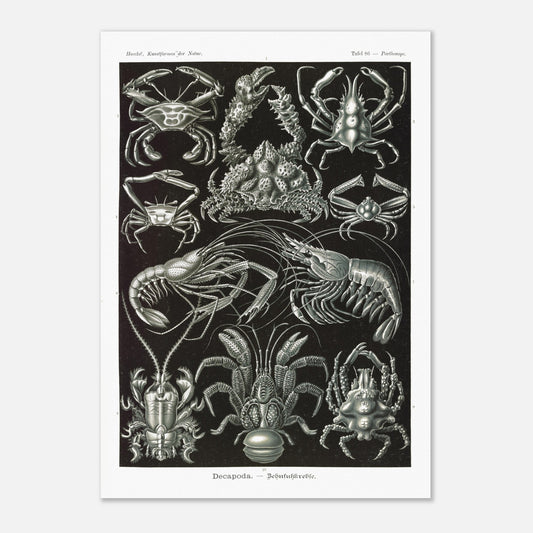Decapods - Reproduction of 19th century engraving - Ernst Haeckel, Kunstformen der Natur
Decapods - Reproduction of 19th century engraving - Ernst Haeckel, Kunstformen der Natur
Couldn't load pickup availability
Engraving reproduction of: Decapods
Original title Decapoda - Zehnfußkrebse
Parthenope Poster - Arthropods of the main class Crustacea, Order Decapoda
Illustration from the book Kunstformen der Natur, which is a collection of artistic lithographs of natural sciences published by the German biologist Ernst Haeckel between 1899 and 1904.
This naturalistic illustration is part of an overall style inspired by Ernst Haeckel, which greatly influenced the emerging Art Nouveau movement at the beginning of the 20th century. This work, illustrating the impressive beauty and great diversity of the biological world, was complemented by a certain amount of scientific information, some excerpts of which are reproduced below.
This information is over 120 years old and some of it may be outdated!
Scientific classification:
Phylum of Arthropods (Articulata) Main class of Crustacea Shrimp Class (Caridonia) Legion of Shelled Crustaceans (Thoracostraca) Order Decapoda
Scientific notice (extract) accompanying the poster print of Decapoda - Décapodes :
The order Decapoda, commonly known as the ten-legged crustaceans, includes the largest, most developed, and most highly evolved of all true crustaceans. They belong to the diverse subclass of the higher Caridonia, grouped under the name Malacostraca. Although this group includes over four thousand different species, which vary considerably in their external form and internal organization, the total number of their body segments remains consistently twenty. Each body segment (somite or metamere) bears a pair of appendages, except for the last, the caudal segment or telson. This remarkable consistency in the number of segments is explained by inheritance from a common ancestral form, while the great variety of forms can be understood by adaptation to different lifestyles and environmental conditions. The subclass Malacostraca is divided into two main groups: Edriophthalma (sessile-eyed) and Podophthalma (stalked-eyed). In the latter, the eyes are mobile on peduncles (Maulfüßer and Zehnfüßer). The best-known representative of the decapods is our common river crayfish (Astacus fluviatilis), the largest of all native arthropods. It is closely related to the large lobster and the small shrimps (Caridina, Figs. 6, 7). In all decapods, the 20 body segments are distributed similarly between the three main body segments: 5 segments for the head (Caput), 8 for the thorax (Thorax), and 7 for the abdomen (Abdomen). The head and thorax are fused on the ventral side to form a united cephalothorax, while the seven abdominal rings remain free. The 19 pairs of limbs are specialized by divisional work into 2 pairs of antennae, 3 pairs of mandibles, 3 pairs of maxillipeds, 5 pairs of walking legs (the first with pincers), and 6 pairs of abdominal legs. Within the order of Decapods, three suborders are distinguished: first, the Macrura with a long, fully developed abdomen (including river crayfish and shrimps, Figs. 6, 7); second, the Brachyura with a short abdomen folded under the belly of the cephalothorax (including crabs or sea spiders, Figs. 1-5, 10); finally, the Anomura halfway between the two (Figs. 8, 9). Among the latter are the strange hermit crabs or pagures, which have adopted the strange habit of hiding their branched, soft abdomen in an empty shell. One of these Paguridae, the coconut thief (Birgus latro, Fig. 9), lives mainly in Indonesia and feeds on coconuts, which it skillfully opens.
Species present on the Decapods - Parthenope naturalist board :
- Parthenope horrida
- Podophthalmus vigil
- Armed Pisa
- Gonoplax rhomboides
- Pisolambrus nitidus
- Stenopus hispidus
- Palaemon serratus
- Albunea symnista
- Lissa Chiragra
- Birgus latro
About this print
About this print
The layout and composition of this reproduction have been the subject of our greatest attention.
- Respect for the format of the original work: in order to faithfully transcribe the artist's intention, the work is not cropped/re-cut except in extreme cases (obvious imperfection, geometry problem, etc.) in which case the cropping will be as light as possible.
- The presence of white margins is sometimes necessary in order to present the work in a balanced manner.
- Each size offered has been specifically composed, therefore, the size of the white margins may vary from one print size to another. Remember to check this detail carefully!
- Print only, frame not included!
Features
Features
- Premium 200gsm matte white paper, durable and strong.
- Natural, smooth uncoated finish, silky to the touch
- FSC certified paper or equivalent certifications depending on regional availability.
- Each print is shipped in sturdy packaging, ensuring safe transport.
- Each print is printed and shipped on demand. No minimum order quantity is required.
Share !









Recently viewed products
We are listening to you
If you are looking for a specific composition, a particular layout, or any other customization need, our team is at your disposal and will do everything possible to meet your requests.
So don't hesitate to...




